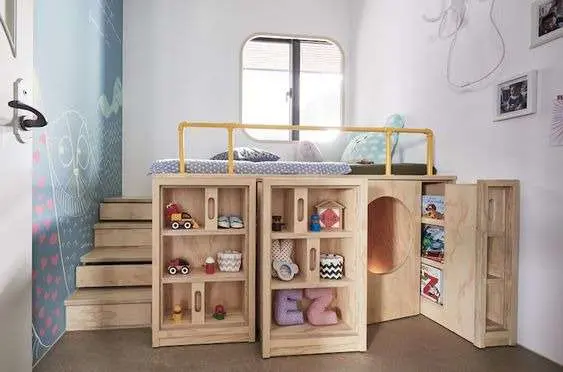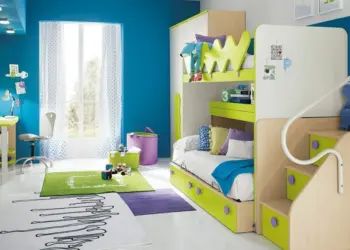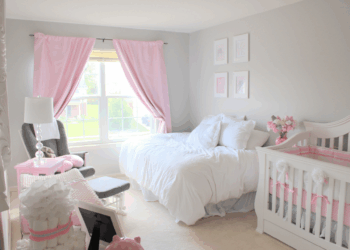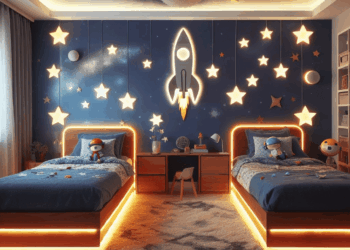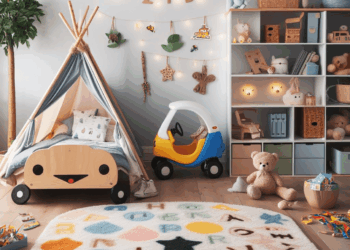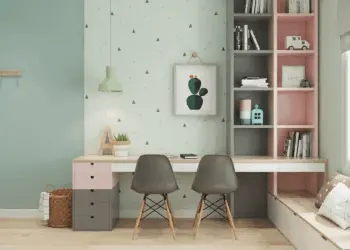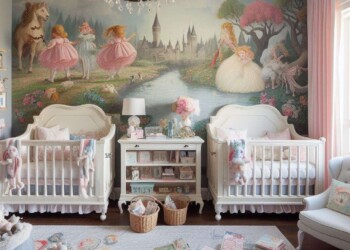Designing a Small Kid’s Bedroom calls for ingenious solutions that balance functionality and creativity.
A child’s bedroom serves as a space for sleep, study, and play. It’s essential that children have the freedom to navigate these dimensions seamlessly. Designing distinct zones, especially in limited spaces, can be tricky. Thus, optimizing the child’s environment is paramount for their optimal growth and development.
You can effortlessly design a charming and organized room for your child, even in a small space. The key to perfect Small Kid’s Bedroom is to select decor and furniture that maximize space while creating the illusion of a larger area. Here’s a guide to crafting a dreamy and efficient kids’ haven within limited square footage.
Zoom on the Small child’s bedroom
For a child’s bedroom in a small space, the key word is tidiness. Go for the essentials!
- During the first years of childhood, everything for the child needs to be within easy reach. That’s why dedicated storage spaces are on the floor and easily accessible.
- The door should be unobstructed and visible to the child, to reassure him and enable him to evolve in an “open” space.
- Toys and books will fit perfectly in cubbies, along a wall or along the headboard to delimit the resting area and the desk.
- Provide a small dresser for clothes, preferably without doors, with racks hanging on the wall and bannettes on top.
- Provide several light fittings: one for the bed, one for the desk, and a central one, accessible to the child if necessary thanks to a small step or a bench, to also develop his autonomy.
Create space for rest and sleep in your Small child’s bedroom
Arranging the bed within a bedroom can be a challenging task, contingent upon factors like the room’s layout, windows, and doors:
- A child’s bed measures between 90 and 120 cm from the age of 2, when it’s time to switch to a full-size bed.
- Choose a raised bed with storage underneath, or a mezzanine bed for smaller rooms. The desk can be placed underneath, keeping the remaining space for the play area.
- In this case, you can place a light blind on the ceiling at the foot of the bed to divide the space and reassure the child, who won’t see the void.
- Ideally, the bed should be placed against a wall, with the window opposite and the door to one side or, better still, opposite.
- As a bedside table, a cube is perfect. It’s the perfect place to put a light source, a pocket, and to store things inside.

- Creative Bed Nooks for your Small Kid’s Bedroom: If your room contains nooks or alcoves, turn them into comfortable sleeping areas. For a more private atmosphere and improved aesthetics, add drapes.

- Enhance the enchantment of the room with bed canopies, adding a touch of magic that not only offers comfort but also visually defines the sleeping area.

- Explore the option of fold-out wall beds if your children share a room, as they can be easily stored away during the day, optimizing the available space.

Create a study environment in Your Small child’s bedroom
After selecting the bed, the straightforward yet functional desk comes into play:
- Ideally, position it against a wall, avoiding placement in front of windows or doors.
- Opt for a basic wall-mounted plank coupled with a workshop-style credenza shelf, serving as a convenient organization spot for your child’s essentials.
- Incorporate two or three compartments above or alongside the floor for storing books and supplies.
- Choose a chair that fits neatly under the desk surface to maximize space utilization.

- Compact Desks: Pick desks that can be folded up or stowed away when not in use. Wall-mounted desks may save a lot of room as well.

A playful, creative space for children in your Small Kid’s Bedroom
The area designated for play and creativity doesn’t have to be extensive, but it should be clearly delineated:
- If you have an available corner in the room, consider painting a third or half of it with magnetic paint, complemented by chalkboard paint on the adjacent sides of the wall. Alternatively, chalkboard paint alone can suffice.

- Place a vibrant and colorful rug measuring around 1 to 2 square meters, or even a generously sized cushion, on the floor. Incorporate storage with columns of racks and shelves.

- Install a wall-mounted peg for hanging containers holding chalk, magnets, pencils, and other supplies.

- Include a compact to medium-sized coffee table that can be easily pushed against the wall, along with a selection of cushions.
- Wall Decals and Murals: Wall decals or murals that provide depth and character without taking up floor space can give the appearance of more room.
Optimize the Small Kid’s Bedroom with storage annexes
You can utilize any available wall or furniture piece for these straightforward and inconspicuous ideas, allowing for easy and cost-effective adjustments to accommodate your child’s age.
- Enhance the door with a panel equipped with pockets for organizing small items.

- Install a coat hook at a child-friendly height for hanging everyday clothing.
- Install decorative wall hooks to hang bags, hats, and other items, keeping the room tidy and adding a playful touch.

- Consider a barrel footstool for both toy storage and as occasional seating for friends.

- Opt for a trunk without a lid for convenient storage of larger items or toys.
- Wall-Mounted Shelves: Keep the floor clear of clutter by mounting open shelves on the vertical walls. These shelves can house toys, books, and ornamental things.
- Modular Storage: Make an investment in space-saving modular storage solutions. These programs might change as your child gets older and expand with their requirements.

- Design built-in storage options to make the most of available wall space. You may have cubbies, cupboards, and shelves made specifically for you.

Minimalistic Decor
Certainly, you’ve captured the essence perfectly. Opt for minimalistic décor to cultivate a clean and uncluttered ambiance. Steer clear of dark shades and intricate patterns that might overpower the room’s visual appeal.

How To Put Mirrors in Small Kid’s Bedroom?
Employ mirrors strategically to reflect light and create an illusion of more space. Mirrored wardrobe doors or wall mirrors can be particularly effective in achieving this.

Attractive color scheme
To create the illusion of a larger space, opt for a cohesive light color scheme that complements each other. Consider using analogous or monochromatic color palettes for a harmonious look.

FAQ
Q: How To Zoom on the Small child’s bedroom?
A: For a child’s bedroom in a small space, the key word is tidiness.
Q: How to create space for rest and sleep in your Small child’s bedroom ?
A: Arranging the bed within a bedroom can be a challenging task, contingent upon factors like the room’s layout, windows, and doors.
Q: How to Create a study environment in Your Small child’s bedroom?
A: After selecting the bed, the straightforward yet functional desk comes into play.
Q: How to Optimize the Small Kid’s Bedroom with storage annexes?
A: You can utilize any available wall or furniture piece for these straightforward and inconspicuous ideas, allowing for easy and cost-effective adjustments to accommodate your child’s age.
Q: How to create A playful, creative space for children in your Small Kid’s Bedroom ?
A: The area designated for play and creativity doesn’t have to be extensive, but it should be clearly delineated.
Q: Why Minimalistic Decor ?
A: minimalistic décor to cultivate a clean and uncluttered ambiance.
Q: How To Put Mirrors in Small Kid’s Bedroom?
A: Employ mirrors strategically to reflect light and create an illusion of more space.
Q: Why We should use attractive color scheme ?
A: To create the illusion of a larger space, opt for a cohesive light color scheme that complements each other.
